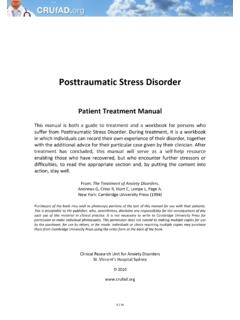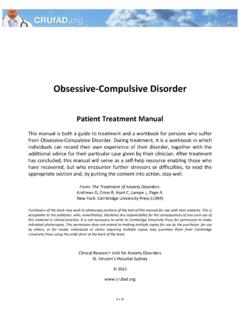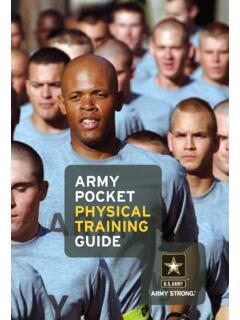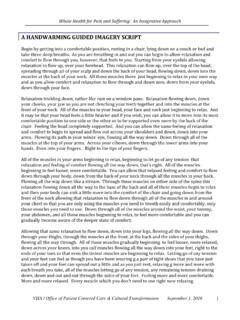Transcription of Generalized Anxiety Disorder - CRUfAD
1 1 | 72 Generalized Anxiety Disorder Patient Treatment Manual This manual is both a guide to treatment and a workbook for persons who suffer from Generalized Anxiety Disorder . During treatment, it is a workbook in which individuals can record their own experience of their Disorder , together with the additional advice for their particular case given by their clinician. After treatment has concluded, this manual will serve as a self help resource enabling those who have recovered, but who encounter further stress or difficulties, to read the appropriate section and, by putting the content into action, stay well. Clinical Research Unit for Anxiety Disorders St. Vincent s Hospital Sydney 2010 iiCONTENTS1. About this programmeWhat is Generalized Anxiety Disorder ?
2 1 Generalized Anxiety Disorder and Everyday Worry ..2 Medication ..22. The Nature of Anxiety and WorryThe Nature of Anxiety ..4 The Anxiety Cycle ..5 Anxiety and Performance ..6 Chronic Anxiety ..7 Why do the Symptoms of Tension and Anxiety Begin? ..7 The Nature of Worry ..8 Worry about Worry ..9 Behaviours that can Maintain Anxiety and Worry ..10 Keeping a Record of your Anxiety and Worry ..113. De-arousal StrategiesControl of Hyperventilation ..15 Slow Breathing Technique ..17 Daily Record of Breathing Rate ..18 What is Relaxation Training? ..19 Importance of Relaxation Training ..19 Components of Relaxation Training ..20 Important points about Learning to Relax Quickly ..23 Difficulties with Relaxation ..234. Thinking Strategies ..25 Identifying Anxiety -provoking thoughts.
3 27 Challenging Anxiety -provoking thinking ..28 Generating alternative thinking ..32 Assumptions and core beliefs ..335. Managing worryProblem solving ..35 Indecision ..35 Worry about worry ..36 Letting go of worries ..376. Structured Problem Solving ..38 Problem solving work sheet ..437. Dealing with Behaviours that Maintain Anxiety or Worry ..448. Keeping Your Practice GoingEmotional problems During Setbacks ..48 Expect To Lapse Occasionally ..48 References and Recommended Reading ..501 Section 1 About this programmeThis programme will aim to teach you to manage your worry and Anxiety by learning tochange the way you think and the way you react to your thinking and other events. Inessence you will be learning new methods of is important to realize that achieving control of worry and Anxiety is a skill that has tobe learnt.
4 To be effective, the skill must be practiced regularly and you will need to takeresponsibility for change. The more you put into the programme, the more you will getout of it. It is not the severity of your Anxiety , or how long you have been anxious, or howold you are that predicts the success of this programme, but rather it is your motivation tochange your is Generalized Anxiety Disorder ? Generalized Anxiety Disorder is a Disorder that is characterized by persistent feelings ofanxiety and worry. The worry is typically out of proportion to the actual circumstances, itexists through most areas of a person s day-to-day life, and is experienced as difficult tocontrol. The Anxiety and worry is described as Generalized , as the content of the worrycan cover a number of different events or circumstances, and the physical symptoms ofanxiety are not specific and are part of a normal response to with Generalized Anxiety Disorder describe themselves as sensitive by natureand their tendency to worry has usually existed since childhood or early symptoms of Anxiety typically experienced by individuals with Generalized anxietydisorder are feeling restless, keyed up, or on edge being easily tired having difficulty concentrating, or having your mind going blank feeling irritable having tense, tight or sore muscles having difficulty sleeping.
5 Either difficulty falling or staying asleep, or restlessunsatisfying Anxiety Disorder is one of the more common Anxiety disorders in thecommunity. A recent Australian survey has suggested that, in a 12 month period, 3 in 100people will have a Generalized Anxiety Anxiety Disorder and everyday worries or gets anxious at some time in their lives. The worry in generalizedanxiety Disorder is identical in nature to that experienced by anybody else, but it tends tobe out of proportion, pervasive, and difficult to control, unlike the worry most peopleexperience. Hence it significantly interferes with an individual s functioning. Theconstant Anxiety -provoking thinking and the accompanying physical symptoms ofanxiety can be disabling, particularly if experienced over a long period of feature of Generalized Anxiety Disorder is that it has usually been present formuch of an individual s life.
6 From time to time, people may become unusually stressed,because of a physical illness or a life event such as divorce, bereavement, or loss (orthreat of loss) of employment. During these times people may worry and becomesignificantly more anxious, but after the stress resolves, the person can usually return totheir usual functioning. This is not Generalized Anxiety Disorder , but a temporary periodof difficulty adjusting to may be taking medication to help you cope with Anxiety . If you are takingmedication, you may need to talk about the issues discussed below with your medicationMany of the medications that are useful to treat a depressive Disorder are also useful tohelp control Anxiety . If your doctor has prescribed you this type of medication,particularly if you have been depressed, it is important that you continue to take themedication for several months, and only stop taking it in consultation with your medication typically has few side-effects, it is safe, and will not cause you to buildup tolerance or become you are ready to stop this medication (usually after you have been feeling calm andin control for a number of months), it is very unlikely that you will experience a relapseof your Anxiety if you have been able to learn and put into practice the strategies taughton this , tranquilizers and sleeping class of medication is the benzodiazepines.
7 They dampen the feelings of anxietyvery effectively, but also produce the following problems: they can interfere with thinking and your ability to remember new information; they can make you feel drowsy and sleepy; they can interfere with your natural sleep cycle and rhythms; they can produce tolerance, so that you might need bigger and bigger doses for thesame effect; they can produce dependence, so that you come to rely on them and experience anincrease in Anxiety without them;3 they can produce withdrawal symptoms when you stop or cut down, producingunpleasant Anxiety -like symptoms; they can make it easier for you not to use the strategies taught in this you are taking this type of medication would already have been asked to gradually cutdown, with the aim to stop completely.
8 If you are experiencing any difficulties with thisprocess, please discuss it with your therapist who can then work with your doctor inachieving the goal of successfully stopping the 2 The Nature of Anxiety and WorryThe Nature of is a normal and healthy reaction. It describes a series of changes in the body, and in theway we think and behave, that enable us to deal with threat or danger; changes that can be veryuseful if you have to respond very the following:You are crossing a wide and busy road at a pedestrian crossing. You suddenly notice atruck that has failed to slow down and will probably not stop, and it is heading in yourdirection. You start running for the safety of the sidewalk some meters away. The brainbecomes aware of danger.
9 Automatically, hormones are released and the involuntarynervous system sends signals to various parts of the body to produce the changes listedbelow. The mind becomes alert. Blood clotting ability increases, preparing for possible injury. Heart rate speeds up and blood pressure rises. Sweating increases to help cool the body. Blood is diverted to the muscles, which tense, ready for action. Digestion slows down. Saliva production decreases, causing a dry mouth. Breathing rate speeds up. Nostrils and air passages in lungs open wider to get in air morequickly Liver releases sugar to provide quick energy. Sphincter muscles contract to close the openings of the bowel and bladder. Immune responses decrease, which is useful in the short term to allow massive responseto immediate threat, but can become harmful over a long so you are able to run very quickly to the side of the road and escape being knockeddown by the you can see, this series of reactions, known as the fight or flight response, account for themany and varied feelings you can experience when you are anxious.
10 In your mind you feel fear,apprehension, you are on edge , keyed up , and your body, you may experience one or a number of the following sensations: trembling or shaking restlessness muscle tension sweating shortness of breath pounding or racing heart cold and clammy hands fast breathing dry mouth hot flushes or chills feeling sick or nauseated butterflies in the stomachThis fight or flight response is useful in the short term, especially if the danger can be dealtwith by physical exertion. But it is of no use in the long term and certainly of little use in moststressful situations today - it does not help to run when the traffic cop pulls you over and itdoesn't help to fight physically when you are threatened by the boss.









